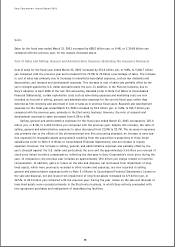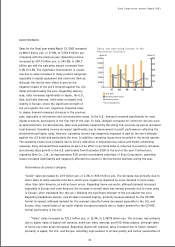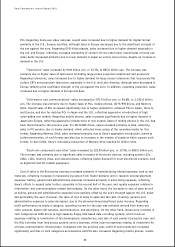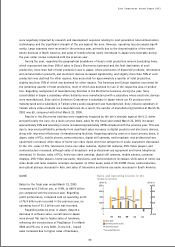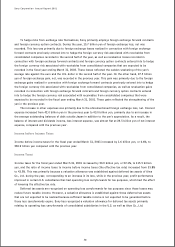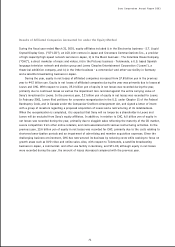Sony 2001 Annual Report Download - page 64
Download and view the complete annual report
Please find page 64 of the 2001 Sony annual report below. You can navigate through the pages in the report by either clicking on the pages listed below, or by using the keyword search tool below to find specific information within the annual report.
Sony Corporation Annual Report 2001
62
PCs. Regarding home-use video cameras, overall sales increased due to higher demand for digital format
primarily in the U.S., Europe, and Asia, although sales in Europe decreased due to the significant strength of
the yen against the euro. Regarding DVD-Video players, sales increased due to higher demand especially in
the U.S. and Europe, reflecting increased availability of content. On the other hand, overall sales of home-use
video decks decreased primarily due to lower demand in Japan as well as lower prices, despite an increase in
demand in the U.S.
“Televisions” sales increased by 90.8 billion yen, or 12.7%, to 805.0 billion yen. The increase was
primarily due to higher sales of televisions (including large-screen projection televisions) and projectors.
Regarding televisions, sales increased due to higher demand for large-screen televisions that incorporate flat
surface CRTs and projection televisions, especially in the U.S. and Latin America, although sales decreased in
Europe reflecting the significant strength of the yen against the euro. In addition, regarding projectors, sales
increased due to higher demand in Europe and Asia.
“Information and communications” sales increased by 279.9 billion yen, or 26.6%, to 1,332.6 billion
yen. The increase was primarily due to higher sales of PCs, mobile phones, CD-R/RW drives, and Memory
Stick. Overall sales of PCs increased significantly due to higher demand for notebook PCs in Japan, the U.S.,
and Europe, and also for desktop PCs in Japan and the U.S., reflecting aggressive introductions of high
value-added new models. Regarding mobile phones, sales increased significantly due to higher demand in
Japan and Europe, reflecting aggressive introductions of new models. Sales of mobile phones in the U.S. had
been discontinued in the previous year. For CD-R/RW drives, sales increased primarily in Asia, reflecting
sales to PC vendors, due to higher demand, which reflected lower prices of the recording media for this
format. Regarding Memory Stick, sales increased primarily due to Sony’s aggressive introduction, aimed at
further penetration, of such format and also due to increases in the number of products which support such
format. In April 2001, Sony’s cumulative production of Memory Stick reached 10 million units.
“Electronic components and other” sales increased by 121.8 billion yen, or 17.0%, to 839.2 billion yen.
The increase was primarily due to significant sales increases of electronic devices, including system LSIs,
CCDs, LCDs, memory chips, and optical pickups, reflecting higher demand for most electronics products such
as digital AV and PC-related equipment.
Cost of sales in the Electronics business increased primarily in manufacturing-related expenses such as raw
materials, reflecting increases in manufacturing output from higher demand, and in research and development
expenses. Selling, general and administrative expenses increased primarily in advertising expenses, reflecting
Sony’s efforts to expand sales further, especially in the second half of the year, and royalty expenses relating to
information- and communications-related technologies. On the other hand, the increases in cost of sales as well
as selling, general and administrative expenses were partially offset by the yen’s strength against the U.S. dollar
and particularly the euro. However, the ratio of cost of sales to sales and the ratio of selling, general, and
administrative expenses to sales decreased, due to the aforementioned significant sales increase. Regarding
profit performance by product category, operating income for the year was primarily derived from home-use
video cameras, digital still cameras, semiconductors, and televisions. On the other hand, losses were recorded in
such categories as HiFD drives (a high-capacity floppy disk-based data recording system), which incurred
expenses relating to termination of the development, manufacture, and sale of such product during the year; and
the WLL (wireless local loop access system) service business, which incurred expenses relating to investment for
wireless communication infrastructure. Compared with the previous year, profit of semiconductors increased
significantly and that of such categories as televisions and PCs also increased. Regarding mobile phones, results








